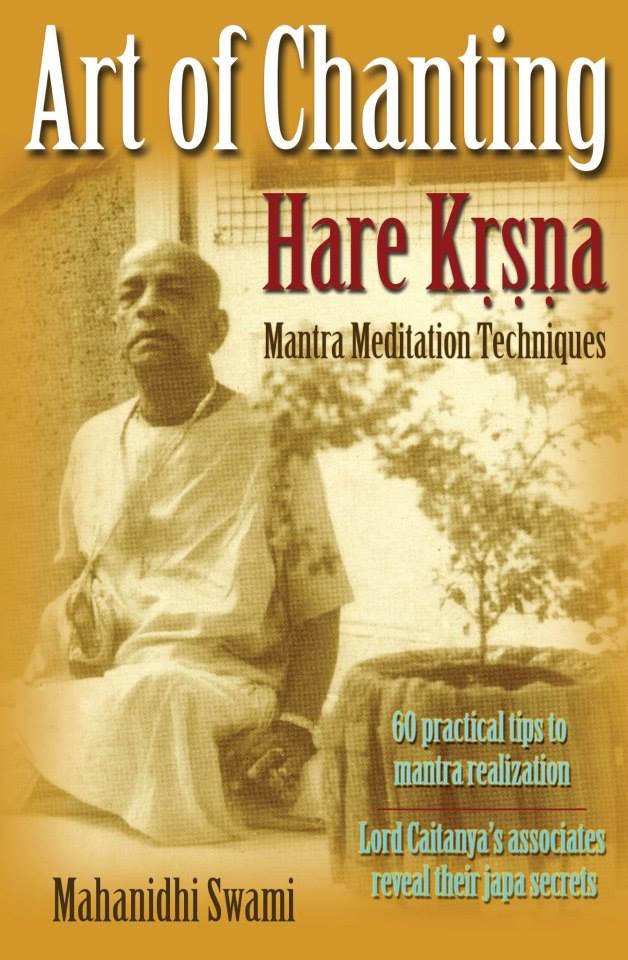Mahanidhi Madan Gopal Das
Harinama-cintamani describes the sadhana-krama, progressive path of chanting Kṛṣṇa’s holy names: “First one must discard the ten offenses. One should clearly and distinctly pronounce the holy names, and meditate on the Syamasundara form of the Lord. One should chant while sitting in front of and beholding the beautiful form of the Deities. One should realize that the name we are hearing and the form we are seeing are one. One will be able to perceive that there is no difference between the seeing and the chanting.
“After attaining the stage where the name and form of the Lord become one, one should then remember the qualities of the Lord. While hearing Kṛṣṇa’s pastimes one develops appreciation for Kṛṣṇa’s qualities. Such appreciation can only develop in the association of devotees. Otherwise, Kṛṣṇa’s qualities do not become manifest to the devotee. The holy name and qualities must merge through constant chanting.
“Next one must practice remembrance of Kṛṣṇa’s pastimes. One should especially meditate upon Kṛṣṇa’s amorous pastimes. The lila smaranam gradually becomes one with the holy name, form and qualities of Kṛṣṇa. At this point, the first rays of nama-rasa, the transcendental mellows of the holy name, dawn on the horizon of perception. The devotee’s practice of lila-smarana progresses and intensifies to the point where he becomes absorbed in remembering Kṛṣṇa’s asta-kaliya lila.”
As Srila Bhaktivinoda describes a sequence of sadhana, Sri Jiva Gosvami depicts a sequence of hearing (sravana krama) in Bhakti-sandarbha, Anuccheda 256: “First the heart becomes purified by hearing Kṛṣṇa’s holy name. When the heart is thus purified one hears descriptions of Kṛṣṇa’s form. When one hears about Kṛṣṇa’s form, one naturally also hears about the Lord’s qualities. When one hears Kṛṣṇa’s name and the descriptions of His form and qualities, one also comes to hear about Kṛṣṇa’s pastimes.”
Srila Prabhupada defines the “actual perfection of chanting” as the gradual realization of Kṛṣṇa’s wonderful names, forms, qualities and pastimes:
“The purification of chanting harināma means as soon as you chant the holy name of Kṛṣṇa–immediately you will see the form of Kṛṣṇa, realize His qualities, and remember the sweet pastimes of Syama. That is pure chanting of the Hare Kṛṣṇa mantra. Śrīla Jīva Gosvāmī says that when a pure devotee chants Hare Kṛṣṇa mantra, immediately all these–nāma, rūpa, guṇa, līlā, parikara, vasiṣṭha…[will appear] Simply by chanting the name you will feel the form of Kṛṣṇa: “Here is Kṛṣṇa.” Nāma, rūpa, guṇa. “Here are the qualities. Oh, Kṛṣṇa is so qualified. He is so kind. He is so magnanimous.” So many qualities you will remember. Nāma, rūpa, guṇa, līlā. Then His pastimes. “Oh, Kṛṣṇa instructed Arjuna. Kṛṣṇa played with His cowherd boys. Kṛṣṇa had very nice talks with the gopis and with His mother Yaśodā.” These things will be remembered. That is factual perfection of chanting.” (SPT 17/1/71)
An excerpt from the book Art of Chanting

